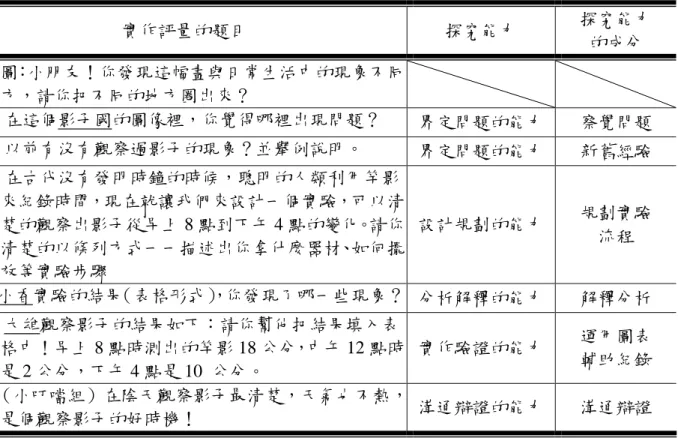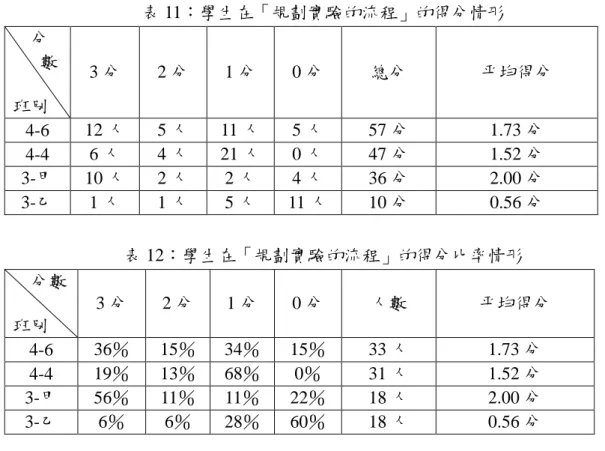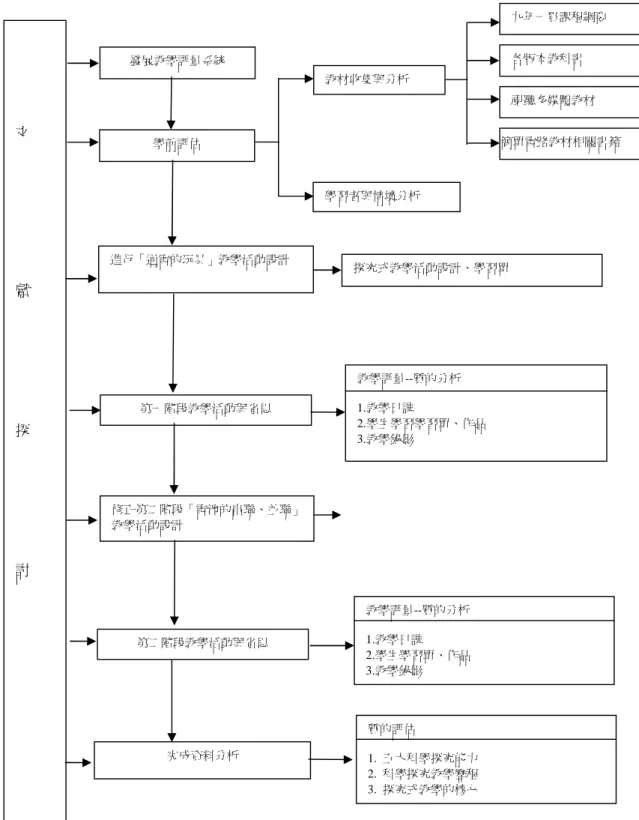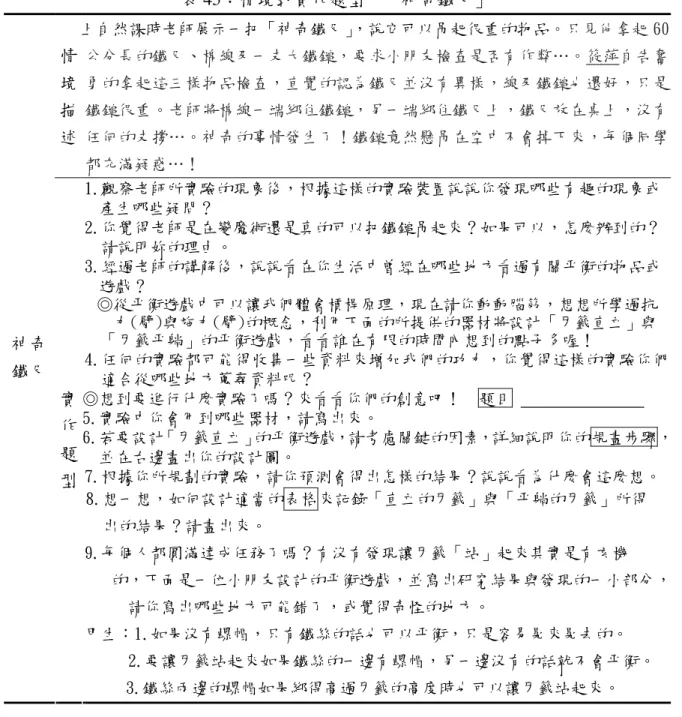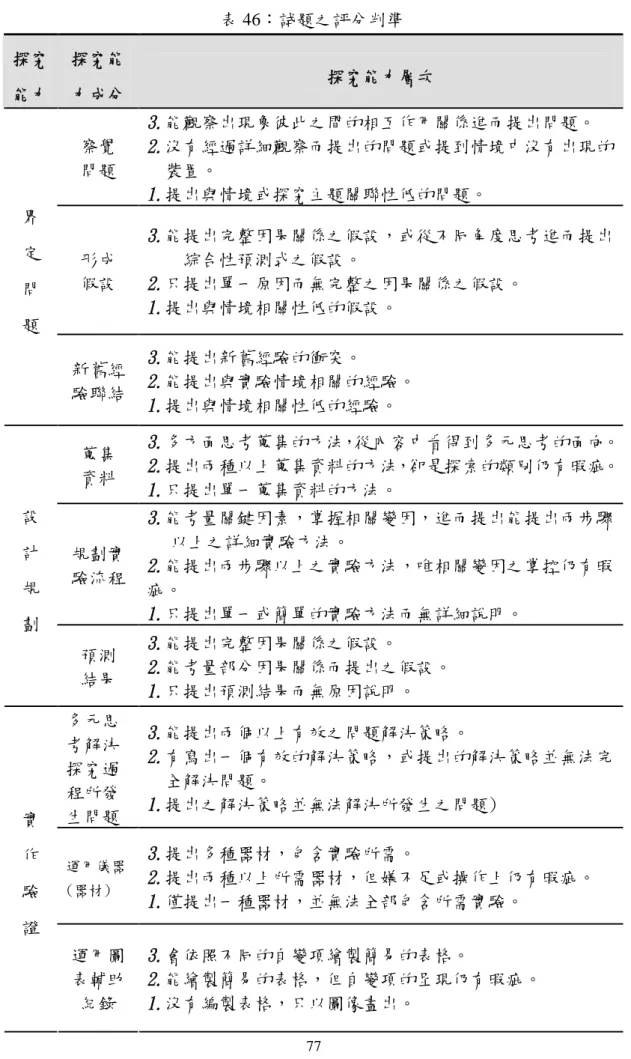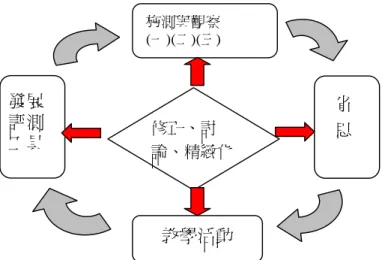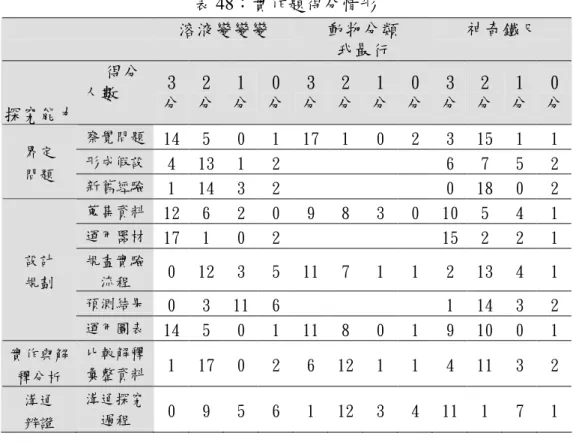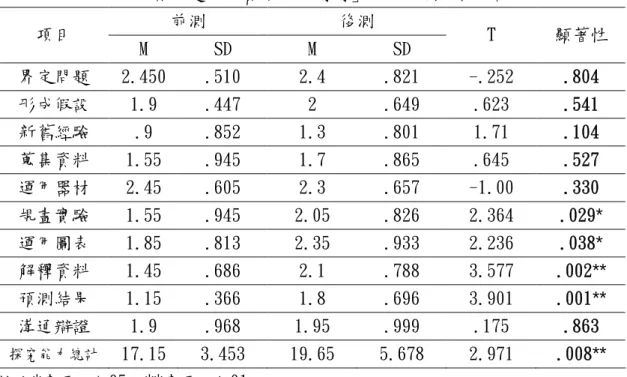Abstract
The main purpose of this three-year study was to develop and validate multiple assessment of scientific inquiry for nine-year-sequencecurriculum in thedomain of“scienceand life-technology” of primary schools. The study of the first and second years adopted action research and invited five elementary science teachers to participate in the study. At the beginning, the study held workshops forteacherenhancement,analyzed thetextbooksand concepts,and explored students’experiences related to learning.In addition,thestudy developed the“teaching objectsofscientificinquiry” according to the“Capability Indicatorsrelating to abilitiesofscientificinquiry in the
Nine-Year-SequenceCurriculum”and relating references.According theabove,thestudy developed multiple assessment of scientific inquiry.
In the second year, the study applied the preliminary multiple assessment of scientific inquiry to researcherteachers’classroom in orderto exploreproblems/solutions,practices/changes,and impact when the teachers teach science with the implement of multiple assessment. According above data, the research revised the preliminary multiple assessment. The study of the third year will adopt interpretive research to interpret practicability, implicit values, and social consequence of the multiple assessment in real teaching situation.
壹、前言
一、研究背景
回顧過去的十年間,呼籲從事教育改革的聲音在科學教育界內,有增多的趨勢(例如, AAAS, 1989; National Science Teachers Association [NSTA], 1992)。在這些教革聲浪中最大的 關注焦點之一為增進科學的教學與學習(高慧蓮、蘇明洲,2000)。 傳統的科學教學實務注重機械性的背誦學習、內容/工作的涵蓋、升學準備、和知識的傳 輸,而不注重讓學生學習和了解科學概念的有意義學習。科學教師非常依賴教科書,以及強 調監控學生的座位工作(seatwork)和「他們自己的教學談話」(Goodlad, 1983),偶而教師 會問學生一些問題,但這些問題大多是收斂式的(convergent)、和只需要學生一個字或非常 短的回應。在科學教室內,科學知識是”從老師滿載知識的頭腦容器內,傾倒入學生頭腦的空 容器中”(Tobin, Briscoe, & Holman, 1990)。傳統的教學實務中,老師扮演控制者的角色,大 多數老師的主要任務為準備學生使之能在標準化的測驗卷裡表現良好。另一方面,在傳統科 學教室內,學生大多被要求去學習教科書中的事實和運算法則,並記憶和回憶它們。在日常 生活的實際情境中,學生很少應用和綜合被教的科學概念。根據 Yager(1992)的研究報導, 超過 90﹪的高中畢業生不會運用(use and act upon)在學校內所學過的科學概念。
實驗室的活動是科學的精華所在,可以允許學生經歷多重感官的經驗。然而很不幸的是, 大多數的實驗室活動,要求學生按照食譜式的步驟描述,一步一步地完成實驗並獲得事先預 設的結果,換句話說,驗證教科書所教導過的事實。
近代的中外科學教育改革如 Project 2061(AAAS, 1989)、Scope, Sequence, and
1. 設計與開發國小中、高年級學生科學探究的多元化評量工具。 2. 設計與開發「提昇國小三至六年級學生對科學探究的能力之多元化評量教學教材」。 3. 預試、評估與修正「提昇國小三至六年級學生對科學探究的能力之多元化評量教學 教材」。 4. 利用科學探究評量工具的實施改進教師科學探究的教學。 5. 探究實施多元化科學探究評量所遭遇的問題與因應策略。 6. 探究實施多元化科學探究評量學生表現的歷程。 7. 探究實施多元化科學探究評量對學生的影響。 8. 效化國小中、高年級學生科學探究之多元化評測工具。 9. 評估有實施與沒實施科學探究多元評量對學生科學探究的差異。 10. 綜合、分析及詮釋各種多元資料,最後提出適切可行之多元化評量模式。
貳、文獻探討
本節擬就科學探究的相關概念、科學探究能力與活動的特徵、和有關科學探究的評量三 大方面探討與本研究相關的理論與文獻:一、科學探究的相關概念
(一)探究(inquiry)的意涵
英文inquiry是起源拉丁文的in或inward(在….之中)和guaerere(尋找);在『牛津英語 辭典』中提到:探究是尋求知識或訊息特別是尋求真理的活動,「探」就是一種搜尋、研究 或調查探究式檢驗活動;是提出問題與產生疑問的活動。根據『辭海』的解釋是說:探究是 深入探討、是反覆研究。另外,吳兆棠(1966)指出「探究」一詞相當於英文的〝Study〞或 〝Research〞,凡是對於某項事實或者問題加以調查(Investigation)、探詢(Inquiry)、討論 (Discussion)、思考(Thinking),以及分析或綜合之結果,對學術上能有所助益的均算在內。然 而Assessment of Performance Unit(APU)於 1989 年對「探究」一詞所下的定義為「進行無法 立即找到答案,或無現成有規則性可供參考套用的活動(task)」(引自溫存儒,2001)。探究屬於思考方式的一種(Welch,1981)。人類為了滿足天生的好奇心,不斷的思考, 透過各種方法獲得答案,解決問題(歐陽鍾仁,1987)。因此,人類天生就有探究的本能。 美國國家研究協會(NRC,2000)曾經對人類探究的本質(the nature of humaninquiry)這樣 描述:
Lesgold et al.(1988)則認為科學探究就如同閱讀、寫作和數學一般,其本身專業知能的 成分也包括: 基本技能(basic Skills) 、概念性理解(conceptual understanding)以及策略
(strategies)。舉例來說,一位放射線學家所具備的基本技能便包括要能判讀X 光的基本元素, 並且能做口述報告(dictation)(報告結果的標準方法);在概念性理解方面則包括要對正常人體 解剖具備一個心智模式(mental model),以及對於不同疾病、手術操作和外傷等在解剖學組織 上所具影響之理解;至於策略方面則包括能夠在診斷時儘可能嘗試去蒐集最多的資料,並且 能有系統地評估那些具有競爭性的假設(competing hypotheses)(引自簡聿成,2000)。
(三)綜合評述
科學探究是科學家用來研究自然界並獲取知識的一種有系統的方法。它包括科學家如何 形成科學知識的過程,科學探究過程所使用的科學過程技能,以及人類在科學探究過程中解 決問題及邏輯思考。而科學探究的方法並非單一的,而且沒有固定的程序和步驟。即使在一 個特定領域中,科學探究可能包含多種不同的探究類型。 從新科學哲學觀所帶來的啟示,許多科學教育學者建議學校內的科學教學活動,應能真 實的反應從事科學探究的精神。然而許多的研究顯示科學教室中科學探究的發展與應用仍然 是沒有落實的。 我國九年一貫課程「自然與生活科技」領域之學習強調應以探究和實作的方式來進行, 強調手腦並用、活動導向、設計與製作兼顧知能與態度並重。是故,科學教師應以探究與解 決問題的方式進行科學教學,並鼓勵學生主動參與科學的學習與探究,提出更多不同的想法。二、科學探究能力與活動的特徵
(一)科學探究的能力
疑性的重新檢討和供其他的科學家用這個解釋從事於新問題的探究。使學生分享他們 的解釋可以提供其他學生以下的機會:(1)提問問題、(2)檢驗證據、(3)指出錯誤的推 理、(4)指出超越證據的敘述、和(5)提議對於相同觀察的另有解釋。分享解釋可以產 生更多的問題或加強學生在證據、現存的科學知識和他們所提出的解釋之間所做的連 結。因此,學生能解決矛盾並強化自己以經驗為基礎的論證。這個特徵依學生自主的 程度由多到寡分成四個層次:(1)學習者形成合理的、合邏輯的論證以傳達解釋,(2) 學習者被指導發展傳達,(3)學習者被提供概括的指導方針以形成傳達,(4)學習者被 給予傳達的步驟和程序。 表 1:教室探究必備特徵與它們的差異 基本的特徵 差異 1. 學習者提出 科學導向的 問題 學習者提出問題 學習者在許多問 題中挑選問題, 提出新的問題 學習者修改 (sharpen)或澄 清由老師、教材 或是其他來源所 提供的問題 學習者從事由老 師、教材或是其 他資料所提供的 問題 2. 學習者決定 收集證據的 方法以應所 提出的問題 由學習者自己決 定收集證據的方 法並收集 學習者被引導收 集特定的證據 學習者被給予資 料並被要求分析 學習者被給予資 料並被告訴如何 分析 3. 學習者從證 據中形成解 釋來回答所 提出的問題 學習者在歸納證 據後形成解釋 學習者被引導從 證據中形成解釋 學習者被給予許 多可能的方法來 使用證據形成解 釋 學習者被提供證 據 4. 學習者連結 自己的解釋 到科學的知 識 學習者獨立檢驗 其他資源並且與 自己的解釋形成 連結 學習者被引導進 入科學知識的領 域和來源 學習者被給予可 能的連結 5. 學習者傳達 並辯證所提 出的解釋 學習者形成合理 的、合邏輯的論 證以傳達解釋 學習者被指導發 展傳達 學習者被提供概 括的指導方針以 形成傳達 學習者被給予傳 達的步驟和程序
(資料來自 Inquiry and the National Science Education Standards, NRC, 2000) 學習者自我引導的量
多 少
來自教師或是教材引導的量
美國國家科學教育標準提出提昇科學探究所強調的重點與以往有所不同(National Research Council, 1996),如下表 2 所示:
表 2:提昇科學探究所強調的重點(National Research Council, 1996)
較少強調 較多強調 1. 科學探究活動挶限在一節課 2. 得到答案 3. 進行較少的探究以便留下時間來完成大 量的內容的學習 4. 學生的想法僅與老師在私底下溝通 5. 僅對科學內容的問題提供答案 1. 科學探究活動超過一節課 2. 使用證據與策略來發展或修改解釋 3. 進行多的探究以伋展、探究的價值與科 學內容知識 4. 學生的想法與學生的作品有公開的溝通 5. 溝通科學的解釋
美國 Oregon Department of Education 研發一份科學探究活動評量的判準,其科學探究活 動包含了下列的四個特徵:
1. 形成問題或假設(Forming a Question or Hypothesis) 2. 設計一個探究活動(Designing an Investigation) 3. 收集與呈現資料(Collecting and Presenting Data) 4. 分析與詮釋結果(Analyzing and Interpreting Results)
式,允許學生可以擁有比較大的自由度去開拓與測試他們的觀念,也可以自行決定他們必須 考慮到的項目或細節,以及自己去思考與設計如何解決這些問題。 Roth(1995)提出科學家在進行科學探究歷程的五個特質: 1. 問題探究的情境中,問題本身往往是定義不明確的。 2. 探究歷程經驗是模糊、不確定的:且科學知識是由社會化磋商形成的。 3. 由既有的有知識狀態朝向可預測的解題歷程。 4. 探究歷程不是孤軍奮鬥,而是同一個團體共用知識實務、資源和對話。 5. 在這個團體裡,每個成員都可能是某知識的專題。 這種探究歷程的環境本質是: 1. 在情境脈絡中學習; 2. 情境脈絡中的問題是模糊、不確定結構組織薄弱的; 3. 從事可被預測的、並能引玫某地步狀態的歷程; 4. 享有科學社群在知識、實驗、資源、辯論和對話等的經驗。 Roth(1995)經由科學家在進行科學探究歷程的五個特質,提出學生宜有的科學探究學 習歷程包括: 1. 確定問題,思索可能的答案,並嘗試驗證其可能性。 2. 設計科學探究的過程和獲得數據。 3. 根據前有的問題和決策,再形成新的問題。 4. 根據先備知識,進行問題的發展。 5. 將活動經驗與科學概念、原理聯結。 6. 分享及討論研究的過程、決策和作品。
「自然與生活科技」領域,不論是哪一個學習階段都缺乏有關NRC 所提出完整探究中所必備 之「學習者連結自己的解釋到科學的知識」的能力指標。也就是當學生經過科學探究形成解 釋時,該如何與科學知識做一連結,並沒有列在能力指標中。
三、有關科學探究的評量
(一)過程技能的評量
以往有關科學探究的評量大多為發展統整過程技能的量表,例如Dillashaw & 0key(1980) 設計了「The Test of Integrated Process Skills」,共三十六題,皆為四選一選擇題;或者是利 用量表來評鑑學生的統整科學過程技能,例如Matheis(1992)曾利用測驗卷測量日本和美國北 卡羅來納州(North Carolina)中學生的邏輯思考能力及統整過程技能。然而利用紙筆測驗的量 表來評鑑學生的科學過程技能,並不能和利用真實科學活動來考驗學生統整能力的情況相提 並論,因此也有些研究進一步採用「實作測試」來真實地測驗學生的統整能力,例如國內學 者楊文金(1987)曾以形成假說、設計實驗、資料處理及下結論等四項統整過程技能為目標, 進行實作評量。根據實作格式測驗之研究發現,國民中學各年級之統整過程技能表現,與我 國國小高年級及國中各年級自然科學實驗教材結構有一致性的表現。
(二)科學探究計分規準
以下研究者舉出一份由Oregon Department of Education (2002-2003)所研發而來的五年級 科學探究活動的計分規準。首先是針對評分規準表格中所提到的項目做簡單的介紹,之後將 進一步介紹老師的計分規準。
(A) 科學探究活動的得分指標
科學探究活動的得分指標包含了下列的四個向度: 1. F 架構一個探究活動(Framing the Inverstigation) 2. D 設計一個探究活動 (Designing an Investigation) 3. C 收集與呈現資料 (Collecting and Presenting Data) 4. A 分析與詮釋結果(Analyzing and Interpreting Results)
(B) 分數的計分(Score points)
表 4:科學探究活動分數的計分 Score of 6 Extraordinary achievement 非凡的成就 Score of 5 Thoroughly developed 徹底地發展的
Score of 4 Work is complete and effective 完全的和有效的
Score of 3 Work is partially effective or complete 部份有效的或完整的 Score of 2 Work is underdeveloped 發展不完全
c.透過所觀察的現象而提出無延伸性的問題
點,在方式上不再是記憶、量化之單一取向,而是以符合情境、學科和學生個別差異的多元 化取向評量,希望透過多元的評量方式讓學生能更完整的表現學習成果,在時機上亦轉為教 學過程中之形成性評量,讓教學中配合評量,評量修正教學,而這樣的觀點也發展出評量取 向的教學-嵌入式評量(embedded assessment)。
嵌入式評量係由Gallagher(1997)於密西根州大學所主持的研究計劃,藉由National Science Foundation and Michigan State University的支持,歷經了四年的研究,致力發展促進教學與評 量整合的評量系統-嵌入式評量,將評量鑲嵌在教學中,讓評量與教學緊密結合(Gallagher, Parker, & Ngwenya, 1999;Wiggins, 1998)。
二、英文部份
Abbagnano, N. (1967). Positivism. In P. Edwards (Ed.), The encyclopedia of philosophy, vol. six. New York: MacMillan.
Abd-El-Khalick, F., & Lederman, N. G. (1998, April). Improving scienceteachers’conceptionsof the nature of science: A critical review of the literature. Paper presented at the annual meeting of the National Association for Research in Science Teaching, San Diego, CA.
Abd-El-Khalick, F., Bell, R. L., & Lederman, N. G. (1998). The nature of science and instructional practice: Making the unnatural natural. Science Education, 82, 417-436.
Abimbola,I.O.(1983).Therelevanceofthe“new”philosophy ofscience forthescience curriculum. School Science and Mathematics, 83 (3), 181-193.
Akerson, V. L., Abd-El-Khalick, F., & Lederman, N. G. (2000). Influence of a reflective explicit activity-based approach on elementary teachers’conceptionsofnatureofscience.Journal of Research in Science Teaching, 37, 295-317.
Alters, B. (1997). Whose nature of science? Journal of Research in Science Teaching, 34, 39-55. American Association for the Advancement of Science. (1989). Project 2061: Science for all
Americans. Washington, DC: Author.
American Association for the Advancement of Science. (1993). Project 2061: Benchmarks forscience literacy. New York: Oxford University Press.
Appenbrink, D., & Hounshell, P. B. (1981). Physical science. Englewood Cliffs, New Jersey: Prentice-Hall, Inc.
Assessment of Performance Unit (1989). Science at age 11(and13, 15). London, H MSO. Bentley, M. L., & Garrison, J. W. (1991). The role of philosophy of science in science teacher
education. Journal of Science Teacher Education, 2 (3), 67-71.
Birenbaum, M. & Cochy, F. J. R. C. (1996). Alternatives in assessment of achievements, learning process, and prior knowledge. Boston: Kluwer academic publishers.
Bombaugh, R. (1995). Peace Corps Fellows enter the urban classroom: Learning to teach by the authority of experience. Doctoral Dissertation, University of Michigan.
Boyd, R. (1991). Confirmation semantics, and the interpretation of scientific theories. In R. Boyd, P. Gasper, & J. D. Trout (Eds.), The philosophy of science. Cambridge: The MIT Press.
Bronowski, J. (1965). Science and human values. New York: Harper and Row Publishers. Bronowski, J. (1966). The identity of man. New York: The Natural History Press.
Bronowski, J. (1978). The origins of knowledge and imagination. New Haven & London: Yale University Press.
Brown, H. I. (1977). Perception, theory and commitment: The new philosophy of science. Chicago: University of Chicago Press.
Burbules, N. C., & Linn, M. C. (1991). Science education and philosophy of science: Congruence or contradiction? International Journal of Science Education, 13, 227-241.
Columbia University.
California State Board of Education. (1990). Science frame work: For California public schools, kindergarten through grade twelve. CA: California Department of Education.
Chiang, S. H. (1994). A study on the teaching behavior of beginner science teachers in secondary school by methods of time series analysis. Taipei, Taiwan: National Science Council.
Chiappetta, E. L., Sethna, G. H., & Fillman, D. A. (1993). Do middle school life science textbooks provide a balance of scientific literacy themes? Journal of Research in Science Teaching, 30, 787-797.
Cleminson, A. (1990). Establishing an epistemological base for science teaching in the light of contemporary notions of the nature of science and of how children learn science. Journal of Research in Science Teaching, 27 (5), 429-445.
Collette, A. T., & Chiappetta, E. L. (1994). Science instruction in the middle and secondary schools (3rd ed.). New York: Maxwell Macmillan.
Collette, A.T., & Chiappetta, E.C. (1994). Science instruction in the middle and science school, 3, 27-47). Columbas U.S.A.:Merrill.
Cox-Petersen, A. (1999). Investigating the Nature of Science through a Museum Research
Apprenticeship Program. 「1999 科學史、哲與科學教育學術研討暨研習會」論文彙編, 62-64。高雄:國立高雄師範大學物理系。
Dana, T. M., & Davis, N. T. (1993). On considering constructivism for improving mathematics and science teaching and learning. In K. Tobin (Ed.), The practice of constructivism in science education. Washington: AAAS Press.
DeBore, G. E. (1991). A history of ideas in science education: Implications for practice , 215-241 . Teachers College, Columbia University.
Driver, R., & Easley, J. (1978). Pupils and paradigms: A review of the literature related to concept development in adolescent science students. Studies in Science Education, 5, 61-84.
Doran, R., Chan, F. & Tamir, P. (1998). Science Educator' s guide to assessment. Virginia: NSTA. Driver, R., Leach, J., Millar, R., & Scott, P. (1996). Young People’sImagesofScience.
Buckingham: Open University Press.
Duschl, R. (1990). Restructuring science education: The role of the theories and their importance. New York: Teachers College Press.
Duschl, R. A. (1985). Science education and philosophy of science: Twenty-five years of mutually exclusive development. School Science and Mathematics, 85 (7), 541-555.
Duschl, R. A. (1988). Abandoning the scientistic legacy of science education. Science Education, 72 (1), 51-62.
Eastman, G. (1969). Scientism in science education. The Science Teacher, 36, 19-22. Eisner, E. W. (1985). The educational imagination: On the design and evaluation of school programs (2nd
ed.). New York: MacMillan.
Feyerabend, P. (1970). Consolation for the specialists. In I. Lakatos & A. Musgrave (Eds.), Criticism and the growth of knowledge. Cambridge, England: Cambridge University Press. Feyerabend, P. (1978). Against method: Outline of an anarchistic theory of knowledge. London:
Verso.
Finley, F. N. (1983). Science processes. Journal of Research in Science Teaching, 20, 47-54. Fleury, S. C., & Bentley, M. L. (1991). Educating elementary science teachers: Alternative
conceptions of the nature of science. Teaching Education, 3 (2), 57-66.
Foster, W. G. & Heiting, A. W. (1994). Embedded assessment. Science and Children, October, 30-33.
Fredericksen, J. R. & Collins, A.(1989). A systems approach to educational testing Educational Researcher, 189, 27-32.
Gallagher, J. J. (1991). Prospective and practicing secondary school science teachers: knowledge and beliefs about the philosophy of science. Science Education, 75(1), 121-133.
Gallagher, J. J. (1993). Secondary science teachers and constructivist practice. In K. Tobin (Ed.), The practice of constructivism in science education. Washington: AAAS Press.
Gallagher, J. J., Parker, J., & Ngwenya, L. (1999). Embedded assessment and reform in science teaching and learning. East Lansing, MI: Michigan state University.
Garofalo, J., Lindgren, R., & Neill, T. (1992). Knowledge developed by a high school teacher participating in a physics research experience. Science Education, 76 (1), 43-50.
Garrison, J. W. (1986). Some principles of postpositivistic philosophy of science. Educational Researcher, 15, 12-18.
Garrison, J. W., & Bentley, M. L. (1990). Teaching scientific method: The logic of confirmation and falsification. School Science and Mathematics, 90 (3), 188-197.
Giroux, H. A. (1992). Border crossing. New York: Routledge.
Good, R. G., Wandersee, J. H., & Julien, J. (1993). Cautionary noteson the appealofthenew “ism” (constructivism) in science education. In K. Tobin (Ed.), The practice of constructivism in science education. Washington: AAAS Press.
Gorman, M. E. (1986). Falsification in experimental and classroom simulations. School Science and Mathematics, 86 (4), 306-321.
Hand, B., Prain, V., Lawrence, C., & Yore, L. D. (1999). A writing in science framework designed to enhance science literacy. International Journal of Science Education, 21(10), 1021-1035. Hanson, N. R. (1961/1958). Patterns of discovery (2nded.). Cambridge: The University Press.
Hanson, N. R. (1977). Is there a logic of scientific discovery? In B. A. Brody (Ed.), Readings in the Philosophy of Science. Englewood Cliffs, New Jersey: Prentice-Hall, Inc.
Harris, K. (1979). Education and knowledge: The structured misrepresentation of reality. London: Routledge and Kegan Paul.
Hempel, C. G. (1966). Philosophy of natural science. Englewood Cliffs, New Jersey: Prentice-Hall, Inc.
Education, 12, 25-57.
Hodson, D. (1986). Philosophy of science and science education. Journal of Philosophy of Education, 20 (2), 215-225.
Hodson, D. (1988). Toward a philosophically more valid science curriculum. Science Education, 72 , 19-40.
Hodson, D. (1988). Toward a philosophically more valid science curriculum. Science Education, 72 (1), 19-44.
Hodson, D. (1993). Teaching and learning about science: considerations in the philosophy and sociology of science. In D. Edwards, E. Scanlon, & D. West (Eds.), Teaching, learning and assessment in science education. London: Paul Chapman Publishing Ltd, The Open
University.
Hume, D. (1962). Of ideas, their origin, composition, connection, abstraction, etc. In D. G. C. Macnabb (Ed.), A treatise of human nature, Book One. London: Fontana/Collins.
Jorgensen, M. A. & Shymansky, J. A. (1996). Assessment in science: A tool to transform teaching and learning. In J. Rohton, & P. Bowers, (Eds). Issue in Science Education, 107-113, Arlington: NSTA.
Justi R., & Gilbert, J. (2000). History and philosophy of science through models: some challenges in thecaseof‘theatom’.International Journal of Science Education, 22, 993-1009.
Kant, I. (1965). Critique of pure reason (translated by Norman Kemp Smith). New York: ST Martin Press.
Kauffman, G. B. (1989). History in the chemistry curriculum. Interchange, 20, 81-94.
Kelly, G. J., Carlsen, W. S., & Cunningham, C. M. (1993). Science education in sociocultural context: Perspectives from the sociology of science. Science Education, 77 (2), 207-220. Kisiel, T., & Johnson, G. (1974). New philosophies of science in the USA. A selective Survey.
Zeitschrift fur allgemeine Wissenschaftstheorie, 5, 138-191.
Krajcik, Blumenfeld, Marx, & Soloway (2000). Instructional, curricular, and technological supports for inquiry in science classrooms. In Mirstell, J. Uan Zee, E. (Eds.) Inquiry into inquiry: science learning and teaching. American Association for the Advancement of Science Press, Washington, DC. pp.283-315.
Kuhn, T. S. (1970/1962). The Structure of Scientific Revolutions (2nded.). Chicago: University of
Chicago Press.
Lakatos, I. (1970). Falsification and the methodology of science research programmes. In I. Lakatos, & A. Musgrave (Eds.), Criticism and the growth of knowledge. Cambridge, England:
Cambridge University Press.
Lederman, N. G. (1983). Delineating classroom variablesrelated to students’conceptionsofthe nature of science. Unpublished doctoral dissertation, Syracuse University.
Lederman,N.G.(1986).Students’and teachers’understanding ofthenatureofscience:A reassessment. School Science and Mathematics, 86 (2), 91-99.
tentative than products. Paper presented at National Association for Research in Science Teaching. St.Lous, MO.
Lincoln, Y. S., & Guba, E. G. (1985). Naturalistic Inquiry. Newbury Park, CA: Sage.
Loving, C. C. (1997). From the summit of truth to its slippery slopes: Science education journey through positivist-postmodern territory. American Educational Research Journal, 34 (3), 421-452.
Lunetta, V. N. (1998). The school science laboratory: historical perspectives and contemporary teaching. In K. Tobin & B. Fraser(Eds.), International handbook of science
education ,249-262.
Matthews, M. R. (1994). Science teaching: The role of history and philosophy of science. New York: Routledge.
Matthews, M. R. (1998). How history and philosophy in the US Science Education Standards could have promoted multidisciplinary teaching. School Science and Mathematics, 98(6), 285-293. Messick, S. (1989). Validity. In R. L. Linn (ed.), Educational Measurement (3rded.) (pp.13103 ).
New York: American Council on Education/Macmillan.
Messick, S.(1992). Validity of test interpretation and use. In M. C. Alkin(Ed.), Encyclepedia of educational research, (pp. 1487-1495). New York: Macmillan.
Miller, R., & Driver, R. (1987). Beyond processes. Studies in Science Education, 14, 33-42. Milne, C., & Taylor,P.C.(1995).Metaphorsasglobalmarkersforteachers’beliefsaboutthe
nature of science. Research in Science Education, 25 (1), 39-49. Moyer, R., & Bishop, J. (1986). General science. Columbus, OH: Merrill.
Murcia, K., & Schibeci, R. (1999). Primary studentteachers’conceptionsofthenatureofscience. International Journal of Science Education, 21(11), 1123-1140.
National Research Council (1996). Naional Science Education Standards. Washington DC: National Academy Press.
National Research Council. (1994). National science education standards: A draft. Washington, DC: National Research Council.
National Research Council. (1996). National science education standards. Washington, DC: National Academy Press.
Nersessian, N. J. (1989). Conceptual change in science and in science education. Synthese, 80, 163-183.
Nott, M., & Wellington, J.J. (1997). Producing the evidence: science teachers’initiations into practical work. Research in science Education, 27(3), 395-409.
Nussbaum, J. (1989). Classroom conceptual change: philosophical perspectives. International Journal of Science Education, 11, 530-540.
Palmeri, A. B. (1995). The consistency between second-gradeteachers’beliefstoward scienceand their science teaching practice. Doctoral Dissertation: Indiana University.
University of Chicago Press.
Popham, W. J. (1997). What's wrong--and what's right--with rubrics. Educational Leadership, 55 (2), 72-75.
Popper, K. R. (1968). Conjectures and refutations in the growth of scientific knowledge. New York: Harper Torchbooks.
Puckett, M. B., & Black, J.K.(1994). Authentic assessment of the young child celebrating development and learning. New York:Macmillan College Publishing Company. Roth, W. M. (1993). Construction sites: Science labs and classrooms. In K. Tobin (Ed.), The
practice of constructivism in science education. Washington: AAAS Press.
Roth, W. M. (1995). Authentic school science: knowing and learning in open-inquiry science laboratories. Netherlands: Kluwer Academic Publisher.
Rutherford, F. J., & Ahlgren, A. (1990). Science for all Americans. New York: Oxford University Press.
Sax, G. (1989). Principles of Educational and Psychological Measurement and Evaluation (3rded.). Belmont, CA: Wad- sworth.
Shapere, D. (1987). Method in the philosophy of science and epistemology: How to inquire about inquiry and knowledge. In N. J. Nersessian (Ed.), The process of science: Contemporary philosophical approaches to understanding scientific practice. Netherlands: Dordrecht. Shaw, K. L., & Etchberger, M. L. (1993). Transitioning into constructivism: A vignette of a fifth
grade teacher. In K. Tobin (Ed.), The practice of constructivism in science education. Washington: AAAS Press.
Smith, M. U., Lederman, N. G., Bell, R. L., McComas, W. F., & Clough, M. P. (1997). How great is the disagreement about the nature of science: A response to Alters. Journal of Research in Science Teaching, 34 (10), 1101-1103.
Stake, R. E., & Easley, J. A. (1978). Case studies in science education. Urbana, IL: Center for Instructional Research and Curriculum Evaluation, University of Illinois.
Stanley, W. B., & Brickhouse, N. (1994). Multiculturalism, universalism, and science education. Science Education, 78 (4), 387-398.
Stenhouse, D. (1985). Active philosophy in education and science. Boston, MA: G. Allen & Unwin Ltd.
Stone, L. (1992). Postpositivist teaching; beyond the myth of prediction. Paper presented at the 1992 JUSTEC conference. Tamagawa University, Tokyo.
Terhart, E. (1988). Philosophy of science and school science teaching. International Journal of Science Education, 10 (1), 11-16.
Tombari, M., & Borich, G.(1999). Authentic assessment in the classroom :Applicationa and practice. New Jersey:Prentice Hall.
Toulmin, S. E. (1953). The philosophy of science: An introduction. London: Hutchinson & Company, Ltd.
and human values, 10 (1), 28-37.
Treagust,D.F.,Duit,R.,& Fraser,B.J.(1996).Overview:Research on students’preinstructional conceptions -- the driving force for improving teaching and learning in science and
mathematics. In D. F. Treagust, R. Duit, & B. J. Fraser (Eds.), Improving teaching and learning in science and mathematics. New York, London: Teachers College Press, Teachers College Columbia University.
Wang, H. C. A. (1999). A content analysis of the history of science in the national science
standards documents and four secondary science textbooks. 「1999 科學史、哲與科學教育 學術研討暨研習會」論文彙編,57-61。高雄:國立高雄師範大學物理系。
Wang, J. R. (1995). A casestudy:An investigation ofteachers’conceptionsofthenatureofscience, science teaching and learning, classroom practices, and other contextual matters. Doctoral Dissertation: University of Northern Colorado.
Wiggins, G. (1998). Educative assessment. San Francisco:
Woolnough, B., & Allsop, T. (1985). Practical work in science. London: Cambridge University Press.
Yager, R. E. (1990). Workshop Science/Technology/Society as Reform in Science Education. Science Education Center, National Taiwan Normal University, Taipei, Taiwan, R. O. C. Yager, R. E. (1994). Science-Technology-Society as Reform. Science Education Center, The
1.在這個影子國的圖像裡,你覺得哪裡出現問題?
2.以前有沒有觀察過影子的現象?並舉例說明。
3.在古代沒有發明時鐘的時候,聰明的人類利用竿影來紀錄時間,現在就讓我們來設計一個

